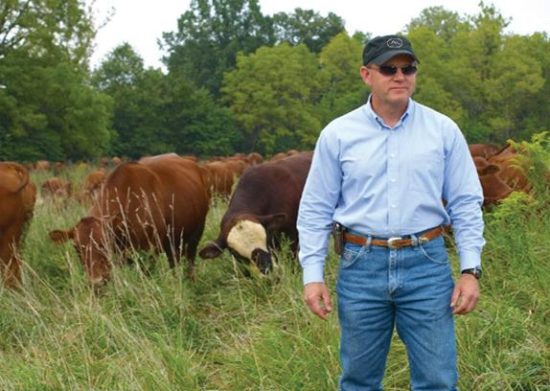It’s hot out there, and for many regions of the country, it’s dry, really dry. Prolonged dry spells create challenges for farmers and ranchers across the country and the globe. Grazing expert Dr. Allen Williams offers drought management tips to minimize the impact drought can have on your pasture, livestock and profits.
“A good practice is to anticipate that every summer you are going to get drought,” says grazing expert Dr. Allen Williams, who has advised thousands of farmers on grazing and regenerative ag practices.
Evaluating the number of animals you graze is one proactive measure in anticipating drought conditions. Williams suggests graziers stock animals not for the best months of the year, but for the months that will be the most challenging.
A second preemptive strategy is to build a stockpile of forage early when you have the spring moisture. “We make sure we are reserving plenty of residual with each graze, so we have plenty of stockpile ahead of us,” says Williams of his own grazing strategy. “I will not in any grazing event allow the cattle to take more than 30 to 40% of the total biomass.”
Before the drought – building organic matter
Rotational graziers have already taken an important step toward mitigating the impact of drought. You move the fence, move the water, and move the shade daily – sometimes multiple times per day. That grazing practice builds organic matter in the soil, enhancing the moisture-retaining capacity of your pasture. An acre with 1% more organic matter holds an additional 18,000 to 28,000 gallons of water.
Being proactive in anticipation of heat and drought means having the tools you need to build that resilience in your pasture. The Shade Haven mobile shade system is one of those tools. With the Shade Haven, graziers maximize grazing land and move nutrients where they need it on the pasture while protecting livestock from heat stress.
“With more and more hot days, it restricts where you can put animals. With the Shade Haven, you are actually moving shade onto a pasture that may not have natural shade, so you can now use that pasture or paddock.” explains grazier and Shade Haven owner, Jim Munsch, who runs 30 cow-calf pairs on his farm in Coon Valley, Wisconsin.
After three decades of rotational grazing, Munch has more than doubled the organic matter in his pasture. Though the area of Wisconsin where he farms is experiencing moderate to severe drought, Munch notes, “Because we have built the organic matter in our soil for over 35 years, we are hanging in there with our regular rotation.”
During a drought – best strategies
If you are not highly prepared for drought conditions – and even if you are – there are strategies to best manage your grazing operation during a drought.
“The first thing you need to do is slow the cattle down,” notes Williams. “That is really important. A lot of people do the opposite.”
In dry times, the opposite – speeding up the rotation – is the worst tactic. “Because that allows less recovery time between grazing events,” explains Williams. “You want to slow them down and hold them back to allow whatever is ahead to recover as much as possible.”
Slowing your roll may mean feeding hay. Be strategic with your bale grazing. “Don’t waste the opportunity to bale graze in areas of the farm that need the most improvement,” advises Williams.
When you feed hay, avoid bale rings. Instead feed the bale intact or roll it on the field. “You want to influence a high-density impact and a lot of manure and urine on the area.”
Mike and Bridget Klein had to slow their grazing during the 2021 drought in central Minnesota. The Klein’s SH600 mobile shade system was a perfect complement to their bale grazing strategy. “The Shade Haven allowed us to move the bale grazing away from the trees,” says Bridget Klein. “We could keep them grazing, keep them rotating. Even though we were bale grazing, we could keep depositing that fertility.”
The Klein’s management practice had a noticeable effect on their pasture. “It was exciting to see how our organic matter increased and how our soil health increased despite the dry conditions.”
Though you may need to allow some overgrazing in a sacrifice area, be careful not to over graze as you move forward, warns Williams. “If you graze too tightly the soil temperature is going to heat up pretty significantly, and you will do more damage and longer-term damage.”
Once again, allow your livestock to consume just 30% to 40% of the leaf volume, leaving behind plenty to shade and protect the soil.
Time to destock
“You can never feed your way profitably out of drought if you are overstocked,” stresses Williams. “It is absolutely not profitable to hang on to all of your stock during a prolonged drought.”
Subscribe to a good weather forecasting service. When it predicts sustained drought patterns, believe it, and take action. Destock your herd early. Determine which animals are least desirable or not performing and sell them. Don’t wait until they lose body condition. “If cattle or sheep are thin, you have lost a lot of value in them if you need to sell,” warns Williams.
Their value diminishes further the longer you wait, as other procrastinating graziers also begin destocking. “So not only are you selling them thin, you are selling them into a down market,” notes Williams. “Be prepared, think ahead, cull ahead – or look for grass elsewhere.”
After the drought
You’ve survived the drought. Now what? “That is when you go back to the drawing board and retool your thought process,” says Williams. “It could happen again next year or the next year. You need to be prepared for drought conditions every year.”

